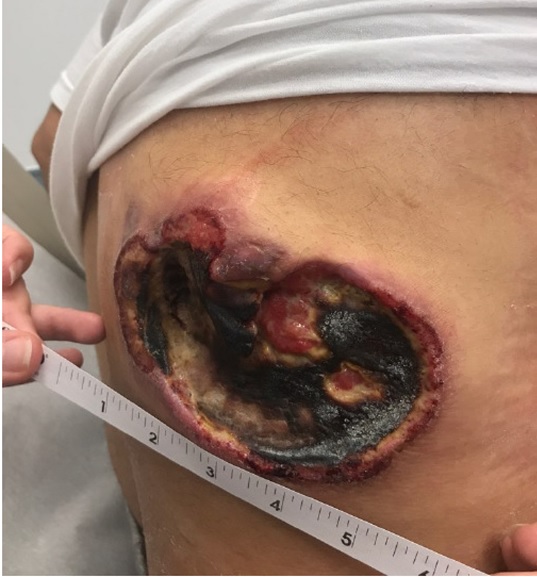Case Presentation: A 42-year-old Spanish-speaking male presented to the emergency department with a 5-month history of worsening fatigue, unintentional weight loss, fevers, and night sweats, along with 4 months of enlarging right flank rash, and 2 months of progressive left eye vision loss. Prior to presentation, he was admitted to an outside hospital for incision and drainage of a right flank mass. He received Vancomycin and Zosyn for cellulitis and was discharged on a 7-day course of oral antibiotics with cultures pending. His social history was notable for a move from Honduras 15 years prior. Symptoms persisted, wound was non-healing, and bacterial culture was negative, so he was referred to the ED for re-evaluation. Vital signs were within normal limits. Patient had no lymphadenopathy or joint pain. He was noted to have an afferent pupillary defect, poor visual acuity, and a temporal field deficit of the left eye. Slit lamp exam revealed keratic precipitates, white cells in the anterior chamber, and vitreous cells. B scan showed vitreous debris without evidence of retinal detachment. Skin exam revealed a 9cm x 7cm x 1.8cm right flank necrotic wound with hardened edges and black discoloration, but no erythema, drainage, or odor. Labs were notable for WBC 3.8 (54% neutros, 28% lymphs, 18% monos, 0.3% basophils, 0.3% eos), transaminitis (AST 209U/L, ALT 301U/L) and elevated lactate dehydrogenase (858U/L). Ophthalmology consultation diagnosed chronic pan-uveitis. Patient had negative serologies for hepatitis, RPR, HIV, HSV, VZV, HTLV I/II, toxoplasma IgG, lysozyme, Lyme Ab, and ANA. Chest x-ray was normal. Biopsy was done and revealed extranodal NK/T cell lymphoma.
Discussion: We present a rare case of extranodal NK/T cell lymphoma manifesting as vision loss and rash, initially presumed to be cellulitis. Extranodal NK/T cell lymphoma is an aggressive type of non-Hodgkin lymphoma that is rare in the United States. It is most common in Central and South America, and almost always associated with past EBV infection and B symptoms. While this lymphoma most commonly involves the nose and sinuses (with most patients presenting with nasal obstruction, sinusitis, and epistaxis), it may involve the skin (second most commonly affected organ), gastrointestinal tract, or eyes. Hospitalists commonly encounter skin diseases, and this case highlights the importance of maintaining a broad differential diagnosis. This young, otherwise healthy patient with a new skin eruption was assumed to have cellulitis and an abscess. His B symptoms and vision changes were overlooked initially, and this resulted in a delay in diagnosis. Extranodal NK/T cell lymphoma is an aggressive cancer, and it is recommended that evaluation be carried out with a sense of urgency, with biopsy performed within one week. This case also included significant social challenges, namely the patient being primarily Spanish-speaking and uninsured. One cannot underestimate the importance of using interpreter services, so as not to miss key historical features of the case.
Conclusions: Extranodal NK/T cell lymphoma is an aggressive malignancy which should be on the differential of patients from Central or South America with new visual symptoms in the context of rash as it requires expedited biopsies and treatment.

